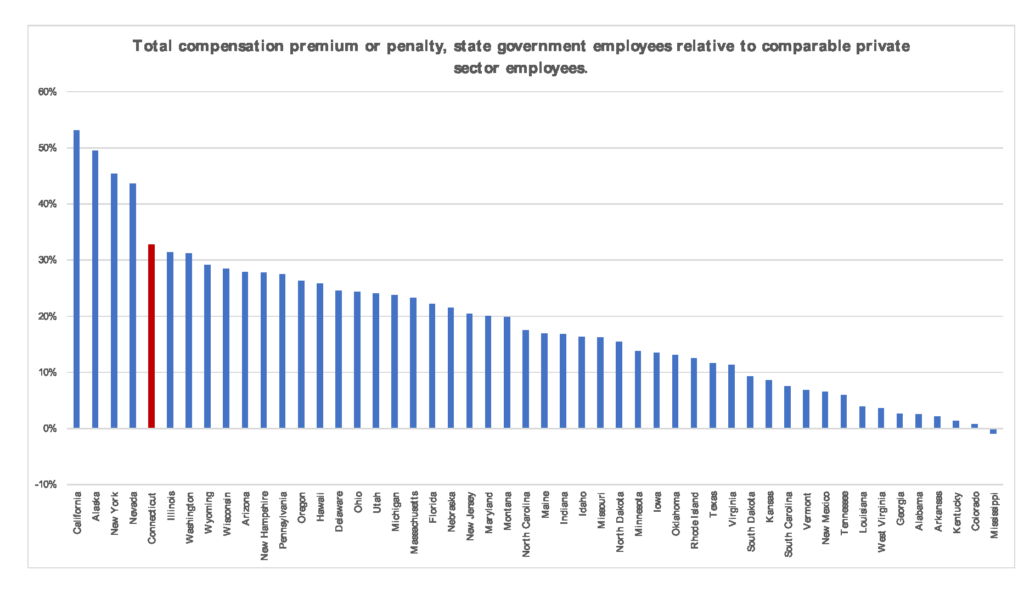
Unionized state workers in Connecticut are dramatically overpaid. This is unfair and unsustainable. It is time for a wage freeze such as former governor Democrat Dannel Malloy imposed.
Democrats have given unionized state employees six straight annual pay hikes since Ned Lamont took office: 5.5%, 5.5%, 4.5%, 4.5%, 4.5% and 4.5%, which compound to 33%. A state worker making $100,000 in January 2019 is making $133,000 today.
Did you get a 33% pay raise? Not likely. National average private sector wages are up only 23.5% over the last six years, according to the Bureau of Labor Statistics (BLS).
Not only that, but unionized state workers’ wages have outpaced inflation by 8% over this six-year period. The Consumer Price Index (CPI-U) is up 25% since January 1, 2019, according to the CPI Inflation Calculator on the BLS homepage.

State workers were not hurting before Lamont took office. According to a 50-state study comparing state employee compensation to private sector compensation, Connecticut state workers enjoyed a 33% premium over comparable private sector workers. Yes, another 33% metric. The 33% premium was the fifth highest among the 50 states. Note, The Townsend Group, which I head, oversaw the study.
Not only is such pay disparity and wage escalation unfair and unsustainable, but it has wrought real damage.
Lamont’s indulgence of state worker unions (so-called SEBAC) has worked to the opposite effect of his stated policy aims and his alleged accomplishments.
The state’s pension problems have festered despite the deposit of $5 billion in extra deposits into the pension fund (the SERS fund), and the state’s social services capacity has been squeezed by the diversion of the $5 billion.
Republicans are not happy that $5 billion has been wasted, i.e. deposited into SERS with virtually no improvement in SERS financial condition. SERS had a $21.2 billion unfunded liability when Lamont took office. As of the latest report of the actuaries, the unfunded liability had declined (improved) only $1.1 billion to 20.1 billion. That is a 5% improvement over five years, or 1% per year. At that pace, SERS will not reach full funding until the 22nd century.

Why such scant progress? Because pensions are pegged off wage levels. When wages increase 33%, future pension costs increase in tandem. In fact, SERS estimated future pension liability has increased from $34.2 billion to $42.0 billion over the first five years under Lamont. That’s a 23% increase. We won’t know until mid-November what the pension liability was on June 30, 2024, the end of the sixth year.
Republicans are unhappy to see such meager results from the fiscal restraints (aka “guardrails”) that they forced Democrats to accept in the fiscal 2017 budget negotiations. Those restraints were designed to improve SERS. They haven’t, because Lamont has overpaid state workers.
Democrats are unhappy, because they expected that the $5 billion would achieve significant pension progress, and, as a consequence, that the fiscal restraints could be relaxed gradually, allowing for more spending on social services.
Lamonth has made no one happy except public sector union members.
Republicans and Democrats should not be opponents on this issue. Their long-term objectives are aligned.
The two parties should join forces and impose a wage freeze, which would lead both to progress on pensions and relief for the state’s beleaguered non-profit social services sector. Once the freeze is imposed, the two parties can fight over how to deploy the saving, i.e. the fair balance between tax relief and augmented social services spending. Without reform, tax increases are inevitable.
![]()
Red Jahncke is a nationally recognized columnist, who writes about politics and policy. His columns appear in numerous national publications, such as The Wall Street Journal, Bloomberg, USA Today, The Hill, Issues & Insights and National Review as well as many Connecticut newspapers.





